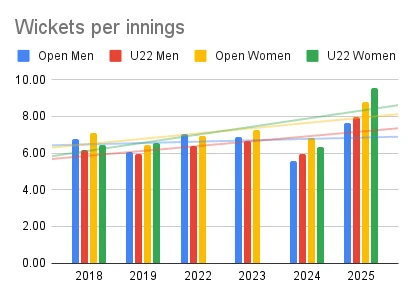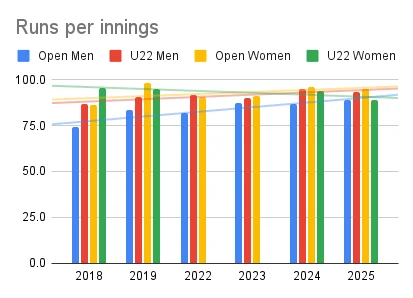By the Numbers: Introducing the Second-Ball Rule
With the second-ball rule to make its international debut at next week's World Cup, Ben De Conno takes a look at the impact of the rule change so far through a data-driven exercise analysing this year's Australian National Championships.

Just three months out from the World Cup in Sri Lanka, the World Indoor Cricket Federation (WICF) announced three major rule updates for the tournament. The key change to the regulations for his event only saw the previous requirement that the batting score changes every three balls (more commonly known as the third-ball rule), now needing to be changed every second ball (second-ball rule).
The aim from the WICF around the rule change was to “make the game faster and more dynamic, with the hope that it will lead to the most entertaining World Cup ever.”
Fast forward a couple of months, and the second-ball rule has been put to the test at the highest levels below international level, with both Australia and New Zealand utilising the new rule at their recent National and Provincial Championships.
The nuances of the indoor game are in the twists and turns in such a condensed area, over a short period of time, and the second-ball rule change has the ability to have a wide-reaching impact.
Whilst there isn’t a big sample size yet, Indoor Cricket News analysed the impact of the rule change across all four divisions from the recent Australian National Championships in Perth. Here’s what we found out:
Open Men
Wickets
The 2024 tournament saw a decrease in wickets taken per innings across the Men’s division. With the second-ball rule in place for the first time, wickets fell fast, increasing by more than two wickets per innings.
Runs
Despite the rule change, and the loss of over two extra wickets per innings, runs are notably still increasing. While we would expect a decrease of 10 runs to correlate with the extra dismissals (with each wicket resulting in a loss of five runs to the batting team), batters have managed to find a way to score more runs, nullifying the extra wickets. Across the last five tournaments since 2018, there has been an increase of almost 15 runs per innings.
Open Women
Wickets
In a similar fashion to the Open Men, the Open Women’s division also saw a dramatic jump in wickets. From just below seven to nearly nine per innings, this is the highest wicket count in the Women’s division in the last several years.
Runs
Once again, there has not been a notable impact on the batters despite the flow of wickets. With nine wickets falling, and still almost 95 runs being scored per innings, the games have become more exciting, and a great test for players. Whilst this was a slight decrease from last year, the level of scores still being posted are still impressive. The data shows a fluctuating trend across the last six tournaments.
*The 2022 and 2023 tournaments had overlapping games with the Under-22 Women. For simplicity, all matches from the Women’s grades have been included in this graph.
Under-22 Men
Wickets
In a continuation of the trend, the Under-22 Men’s division also had a sharp increase in wickets. Generally known to be an more aggressive division, with not many dot balls, it is surprising to see such a vast difference from last year, with nearly eight wickets falling per innings.
Runs
While the wickets accelerated, the number of runs has stayed consistent from last year, a consistent trend over the past few tournament. This division has seen steady scores across the last six tournaments, with just a slight increase since 2018.
Under-22 Women
Wickets
The Under-22 Women’s teams combined with the Open Women’s competition in 2022 and 2023 during the round-robin phases. Within its own tournament in 2024, 6.35 wickets per innings were taken, but there was a 50% increase in dismissals in 2025, the biggest increase we’ve seen across all divisions, with nearly 10 wickets being taken per innings.
Runs
Impressively, despite wickets tumbling, the total scores have held strong, only dropping by 5.0 runs per innings. The Under-22 Women division provides some of the best entertainment the sport has to offer.
Totals


In totality, wickets increased from 6.08 wickets per innings in 2024, to 8.50 wickets in the 2025 competition, an almost 40% increase.
Initial concerns were that scores would decrease, and batters would struggle to stay in the game. Using this year’s Australian National Championships as a proxy, we can see that scores are keeping to a similar level, which for the batters of the international sides who will play in Colombo next week, may be encouraging news.
Of course, the World Cup brings a new venue, different teams, players and a packed schedule over a week of play. Whilst this data analysis provides some insights from an Australian National perspective, the second-ball rule is not the only cause of these statistical outcomes. Though if some of these statistics are anything to come by, the WICF may get their wish for a more entertaining World Cup.
How will the new rule fare at the international level? Next week we will find out.
Image: Dylan Burns Photography



